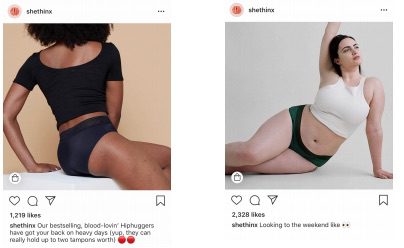Are you showcasing diversity on social media?
From guest author Margot Alais
You don’t realise how important inclusive imagery is, until it smacks you in the face.
Growing up and simultaneously struggling with my sexuality, it was hard for me to conceptualise who I was, or where I fit in, because I had next to no representation of gay women—did feminine lesbians even exist? For a decade I only had Ellen DeGeneres to go by, so I guess not. It is only in recent years that I’ve seen representation increase and diversify, and with this came a breath of fresh air, a feeling of comfort and familiarity. It felt so good to be able to see so many of my own experiences reflected. I wrote about this in a recent blogpost on More Margot.
Diverse representation and inclusive imagery extends a warm, long-awaited hug to the minority identities out there, but quite simply, it’s just a more accurate and honest representation of society’s makeup, and it’s something we should all be striving for. Diverse representation isn’t solely a matter for books, television and film. It’s also important in advertising and marketing—and when so many of our interactions with brands happen on social media, the ways businesses approach their social media practice is really where we should look to.
Benefitting from diverse representation
Some brands might be on the fence about making commitments to represent identities that lie outside the status quo. They may be concerned about being viewed as too political, or that by shedding light on one audience, they may alienate another. There shouldn’t, however, be anything political about an honest representation of our society and, as many brands have shown, they can benefit from diverse and inclusive imagery. This is because diverse representation can become a learning opportunity for brand and consumer alike, increasingly spreading awareness and understanding. It has the power to normalise marginalised identities, and promote acceptance and togetherness. It allows brands to blaze a trail and become active contributors to society’s evolution, and, from a social media perspective, brands are able to benefit from positive sentiment, and give their community management the opportunity to thrive.
Blazing a trail & positive sentiment
I remember the first time I saw THINX being advertised in my Facebook and Instagram newsfeed. THINX sell period-proof underwear, a smart product in itself, but it was something else that was really getting my attention. All the models they featured were racially diverse and completely untouched, with visible stretch marks and other kinds of ‘imperfections’. I can recall scrolling down and seeing a sea of praise and gratitude in the comments. Something as simple as showing stretch-marks had evoked a strong emotional reaction. Women were writing that they were proud of their ‘tiger marks’ and that it was refreshing to see models show them off too.
The inclusive imagery didn’t stop there either, it would’ve been easy to just show conventionally beautiful women and bodies, with a visible stretch mark here and there. THINX went further, and made an effort to showcase different body shapes and sizes through their social media content, and featured a trans man in one of their advertising campaigns, a demographic rarely considered in the marketing of menstruation-related products.

In Australia, Target’s seamless and consistent inclusion of children with disabilities throughout their digital and print content, is truly commendable—particularly when people living with disabilities are one of the most underrepresented groups.
Target doesn’t make their inclusive imagery into a spectacle nor is any special attention drawn to it; the copy that corresponds with their posts merely outlines their products. Their diverse representation needs no rationale, it’s simply an honest representation of Target’s customers. Similarly to THINX, this representation doesn’t go un-noticed; with each new post showcasing diversity, customers flood the comments with support for their campaigns, and mothers thank Target for giving their children the representation they crave.

Through something as simple as representation, an incredible volume of positive sentiment is generated. Diverse representation and inclusive imagery resonate positively with so many perhaps because the commonly represented identity is actually fairly narrow and hard to relate to. We’re not all perfectly sculpted, eternally youthful, heterosexual, cisgendered human beings, with white skin, able bodies and conventionally beautiful features. When diverse representation has been scarce for so long, seeing it being championed by brands we all know and love is extremely heart-warming and comforting—not just for those whose identities are finally being represented, but for their families, their friends, their allies.
Exercising the full potential of community management
It would be naive to assume, however, that the only consequence of diverse representation is positive sentiment. There are certain identities that many brands or businesses are concerned about representing because it might alienate audiences or cause backlash. Indeed whilst diverse representation shouldn’t be political, some identities, such as LGBT+ identities, are political because they , unfortunately,have to be. In these cases, it’s up to the brands and businesses to actually decide if they are willing to stand their ground and represent these identities, despite the potential for backlash.
In June of this year, the National Rugby League did just that. After the women’s State of Origin match, which NSW won, Vanessa Foliaki and Karina Brown, a couple who play for opposing sides, shared a kiss. The NRL decided to share the post-game moment on their Facebook page, sparking some homophobic responses. Instead of panicking and removing the post, or even just ignoring the comments, the NRL decided to use this opportunity to make a stand through their community management. Their subtly humorous responses to naysayers were quickly picked up by the national media, who praised their defence of Foliaki and Brown’s public affection.

The NRL’s approach to their community management was incredibly refreshing. For Koala, an Australian furniture company, this kind of community management is business as usual; their approach to community management is one of the things they’re known and celebrated for.

Koala’s tone of voice is generally quite playful and cheeky, but still approachable and sophisticated. A recent Facebook post went live on their page, featuring a same-sex couple in their bed enjoying Koala products. It’s important to note that Koala is known for their racially diverse talent, and that one of the men represented in this post is an Asian man—adding another layer to the representation. While some customers expressed love for the ad, similarly to the NRL’s post, negative feedback was left as well. Instead of sticking to a cookie-cutter routine of thanking customers for their feedback, and stock-standard responses, Koala was quick to respond with a witty comment that both shutdown the negativity and plugged their product.
These kinds of approaches to community management give personality to a brand, and invite customers to interact, creating a real sense of community. By taking a stand on a certain issue and having a clear identity illustrated through community management, brands and business become multi-dimensional and strengthen their relationship with consumers. It’s this element that can really influence how audiences view a brand or business’ social media content, and changes it from “yet another ad I see in my newsfeed” to “let me see what this new post is all about”.
A changing landscape
With an evolving social conscience, brands and businesses need to adapt and understand that it’s no longer enough to stand idly by. Diverse representation is craved, and when brands and businesses deliver this representation, it isn’t ignored; it’s picked up by the media, it’s picked up by influencers and consumers are making the effort to spread their support for brands and businesses that are finally making the conscious decision to be inclusive.
Through all the noise accumulating around this issue, and brands being held accountable for how and who they represent, diversity in advertising certainly doesn’t seem like a passing fad. With certain brands and businesses setting themselves up as trailblazers in this respect, and getting noticed for their handling of community management, it’s clear diverse representation and inclusive imagery is something that businesses need to pledge a commitment to, or risk falling behind.
Are you looking for some diverse imagery? Try these resources:
https://www.canva.com/learn/canvas-natural-women-collection/
